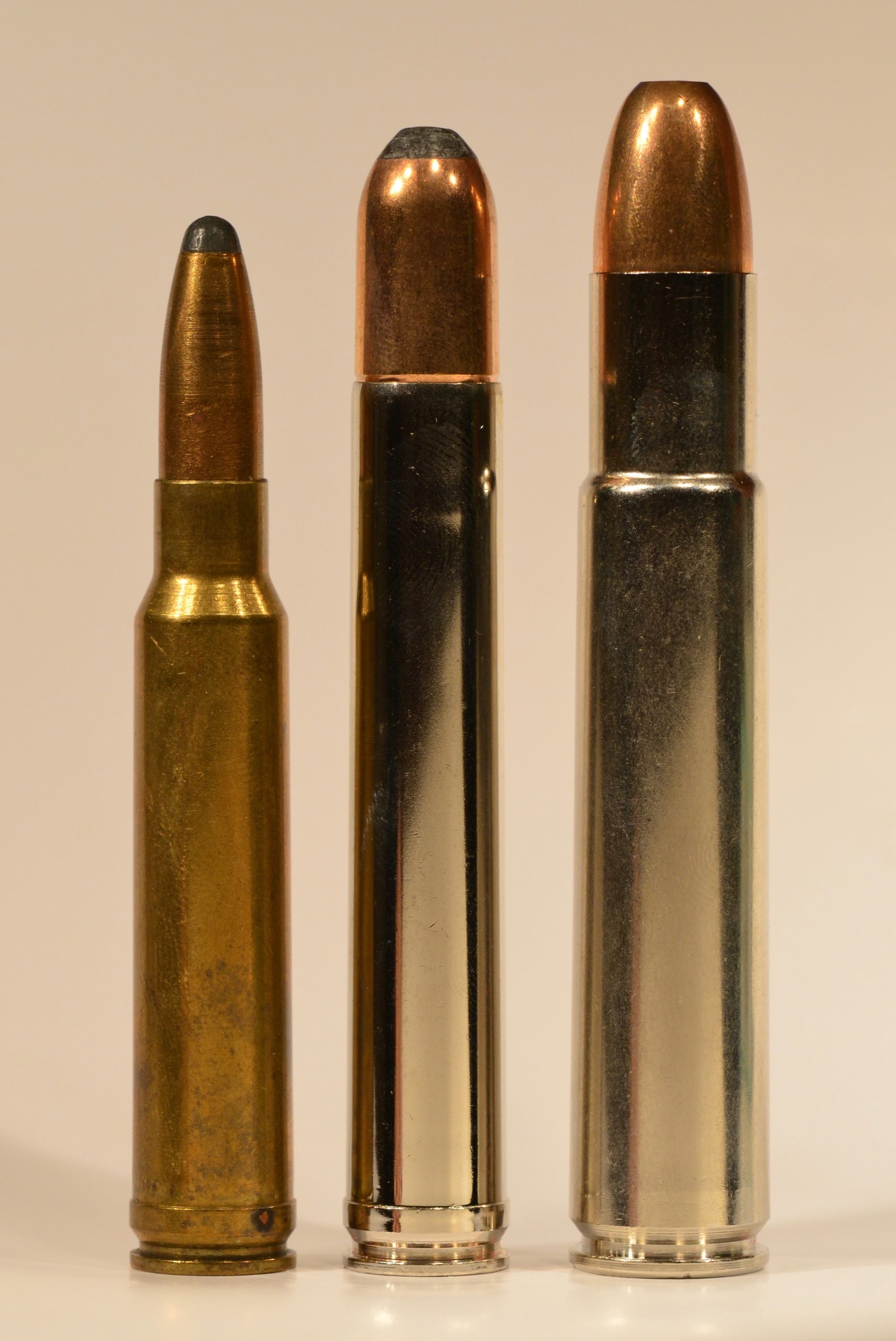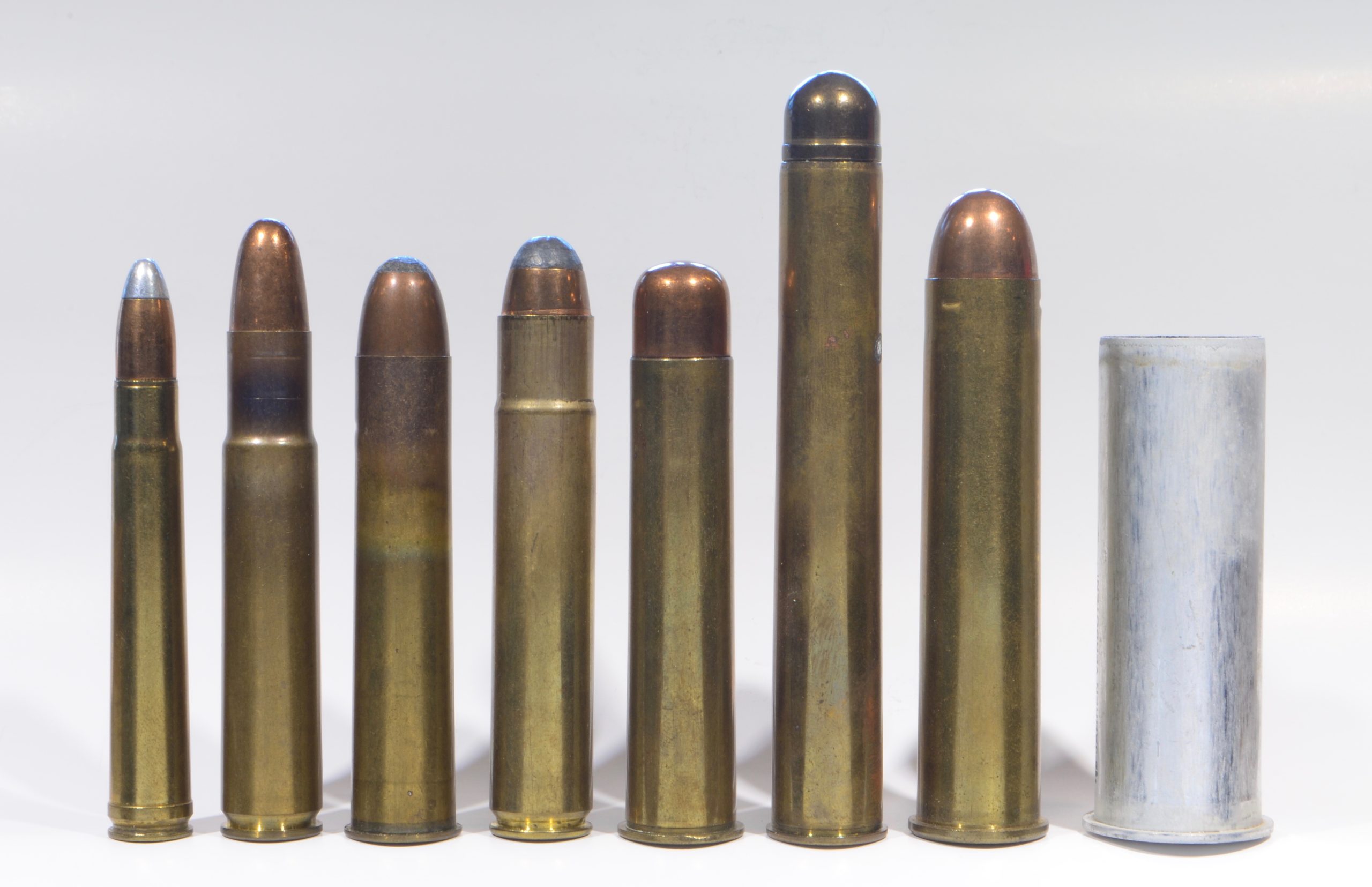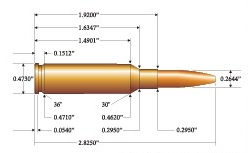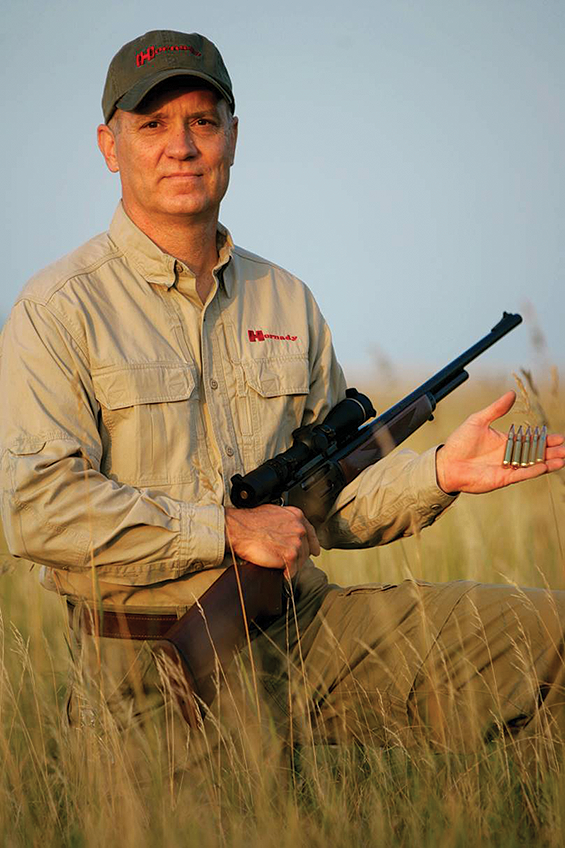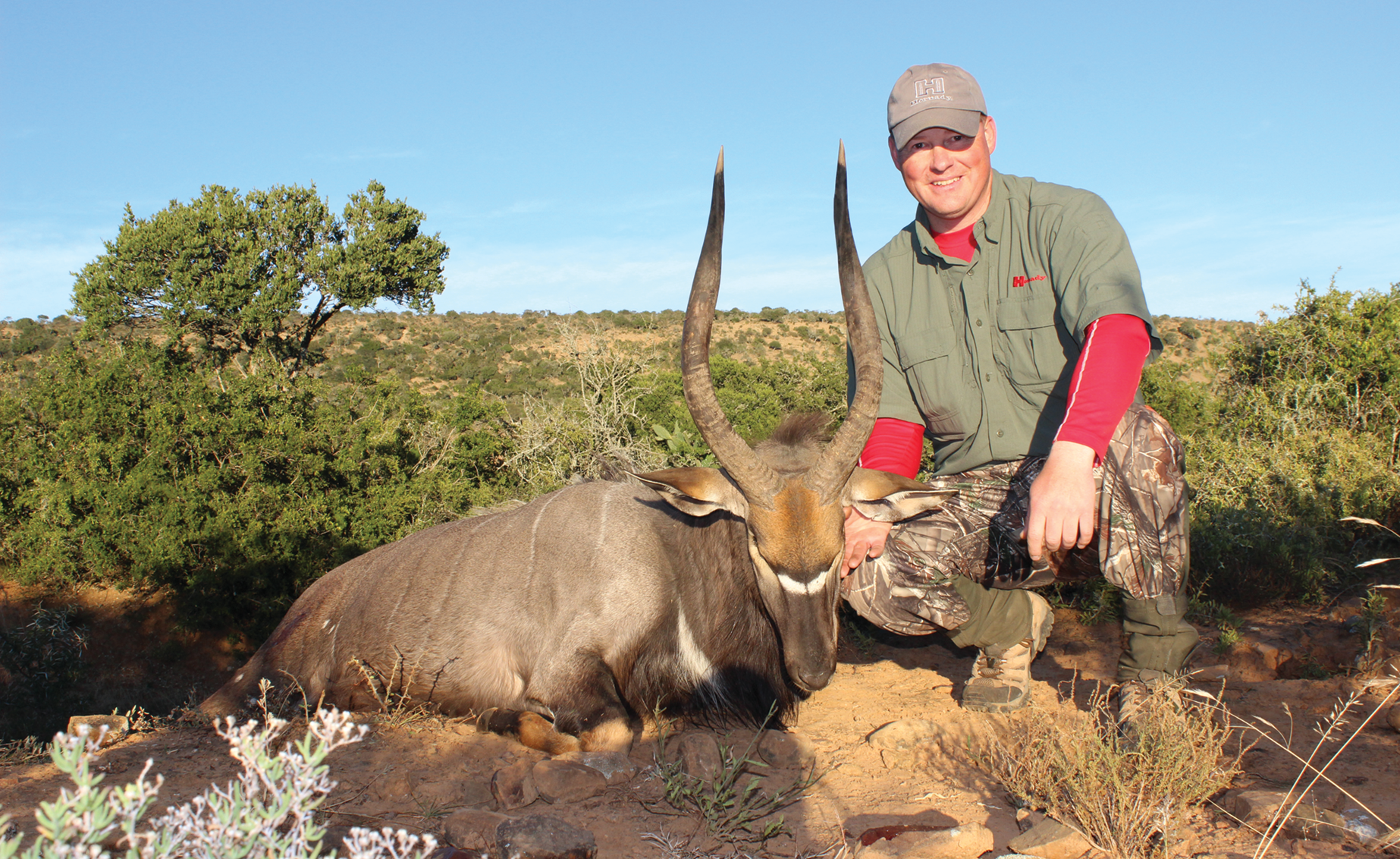Ammo Spotlight: .404 Jeffery / 10,75 x 73mm
By Pierre van der Walt
Cartridge History
Generally known and popular under its British designation, this cartridge is also known in Germany as the 10,75x73mm. Although the cartridge is associated with the British gunmaking trade, the United States pioneered the .423″ bore with the little .44 Henry cartridge of 1873 and then abandoned the calibre. Things then went quiet on the .423″ bore front until the Austrian introduction of the 10,75x57mm Mannlicher-Schönauer in 1900; a cartridge that did not go far.
The British eventually popularised the .423″ bore when the famous William Jackman Jeffery Company introduced the .404 Jeffery in 1905. I know that some readers may have known this all along, but also that most readers will immediately sit upright and say: ‘Wrong! It was 1909!’
I first became aware of 1905 as the date of the .404’s birth when I was shown a photograph of an unusual cartridge. It all started when the South African collector Petr Skrela obtained a sample of a .450/400×3″ from George Black in Bloemfontein. The cartridge’s rim had been turned off to modify it to rimless, bolt action configuration. It turned out that the rifle for which the cartridge had been made was a magnum length bolt action Rigby; which action size Rigby started using in 1904 with Rigby rifle, serial number 2345. The question arose as to why Rigby had taken this unusual step.
The answer is; to compete with the .404 Jeffery, as Rigby did not have a competitive rimless bolt action cartridge at the time. To support this statement I need to backtrack a little. Jeffery had a specific method of referring to cartridges in his catalogues.
For example, even by 1910 he referred to the .450 No.2 as: ‘The New 1903 Model .450 No.2 Cordite Express Cartridge. On page 55 of the same 1910 catalogue he refers to the .404 as: ‘The New .404 Rifle, 1905 Model, Rimless Cartridge’. This was an early pointer to the correct birth date of the .404 Jeffery and the absence of a competitive cartridge which prompted Rigby’s behaviour.


More proof that the .404 Jeffery came about before 1909 comes from a letter from Burma, dated 31 July 1907, written by one Percy Smith, congratulating Jeffery on a delightful rifle. This letter can also be found in the Jeffery catalogue and is definite proof that rifles had been ordered, built, shipped to Burma, used and reported back on by 1907.
The final nail in the 1909 coffin however comes from a drawing named ‘Tracing 24’ dated 18 October 1905 depicting the .404 cartridge. Subsequently two other .404 drawings from 1907 (Kynoch AQ12/24) and 1908 (Eley 158) respectively have been found. There you have it!
Jeffery did not retain the .404 as a proprietary cartridge as many of its opposition did with cartridges they introduced. All gunmakers could chamber rifles for this cartridge, and most did, which naturally resulted in a fair degree of popularity and a hell of a lot of barrel dimension inconsistency.
About the .404’s popularity John Taylor wrote: ‘I can say at once that it is one of the most popular and most widely-used calibres throughout the big game hunting world. Altho I have only mentioned two firm’s names in connection with it, most gunsmiths, including the Germans, listed rifles of this calibre in their catalogues – which speaks for itself.’
The territories now known as Kenya, Tanzania, Zambia and Zimbabwe adopted the .404 Jeffery as an official game department standard issue chambering. The cartridge saw tremendous service in this role, acquitting itself magnificently. One can actually stop at that as it ends all arguments.

The hands and the 3½” long .404 Jeffery cartridge give perspective on a hippo’s thick skin.
Due to its base and rim diameter being unusual in the US, the cartridge lost popularity after World War II. The Americans could at the time still not unglue themselves from their limiting preoccupation with .30-06 and .375 cases, as the once mighty British sporting ammunition industry gradually collapsed and big bore ammunition production eventually terminated. Fortunately sufficient stocks of ammunition floated around until 1963 when Dynamit-Nobel commenced production again. This availability of cases kept the .404 going while other British cartridges faltered.
Several cartridge case manufacturers such as Bell, Hornady, Norma and Bertram eventually began manufacturing .404 Jeffery cases, and a wide range of ammunition can now once again be had. The long and the short of all this is that the case and cartridge were revived.
America eventually discovered the .404 case. Dakota Arms lead the way when Don Allen based most of the cartridges in his proprietary line-up on it. Then John Lazzeroni modified it to serve as a basis for some of his designs. Just before the turn of the century a really big name in the cartridge world also came under the .404 Jeffery case’s spell. Remington based its Ultra Mag and Short Ultra Mag cartridge ranges on it; albeit slightly shortened and with marginally rebated rim. Around the turn of the century Rick Jamison and other Americans began using it as a basis for their wildcats, commercial and proprietary cartridges in pursuit of the short-fat benchrest philosophy.
As a result of the US awakening to it, this sensible big bore case configuration now at least enjoys a new surge of popularity. One can only hope that the Yanks will discover the .404 cartridge itself as well. The .404 Jeffery is still very much in business in Africa where it has enjoyed uninterrupted adulation for over a hundred years and it is one of my favourites.
It took a while before the 6.5 Creedmoor captured the imagination of the American shooting fraternity, but when the 6,5mm penny finally dropped, it did so big time. Today the 6.5 Creedmoor is the best-selling long-range, match cartridge on the planet.
Characteristics
The first thing to come to grips with regarding the .404 Jeffery is that its groove diameter is .424″ and not .404″. At .412″ not even its bore diameter is .404″. Where the .404 designation comes from cannot even be guessed at, but I assume it has something to do with the .303. Fact is that it is of larger calibre than the famous .416 Rigby and not every hunter is aware of that.
In original cordite configuration the cartridge launched a 400-grain bullet at 2,125 fps from 28″ proof barrels. In actual hunting rifle configuration that probably meant around 2,050 fps. Yet it worked. Unlike humans that grow softer with each generation, African animals seem to grow tougher, because this moderate velocity load proved immensely effective in Africa at the time, whereas modern hunters scorn 2,125 fps of muzzle velocity in bolt action cartridges. Although Taylor mentions a number of reported instances of bullet failure (solids), he concludes that ‘I cannot see that the .404 would have become so popular if its slugs
habitually behaved so badly.’ I think Taylor was just filling the page here like he did on occasion, as he was not so accommodating when he discussed the metric 10,75x68mm Mauser. At 2,125 fps even 4th Generation (full metal jacketed) solids fail more or less equally often or equally rarely in most large bores. Today there are excellent bullets for the .404 on the market and the modern hunter can rest assured that if he loads up with any quality bullet for this cartridge, he will be well equipped.
It was also available in 300-grain bullet configuration. Velocity with these hovered around 2,625 fps in proof barrels and around 2,550 fps in hunting rifles. As expected this pushed Green-Band velocity parameters and problems did occur with the original 4th Generation (jacketed soft point) 300-grain HV factory load, due to incorrect short range application, but none of the modern .404 bullets seem to suffer from this shortcoming; American bonded core bullets in particular. At a maximum average pressure of 52,938 psi (360 MPa) crusher, measured in terms of the CIP protocol, the .404 Jeffery’s prescribed pressures are moderate. It was a good idea in the days of heat sensitive Cordite, and it remains a good idea for dangerous game cartridges to this day, but it is not in line with modern trends. We must perhaps all sit down and develop reasonable pressures for modern propellants in classic cartridges. There are modern propellants that perform remarkably consistently despite surprising changes in the temperature and humidity. Examples are those propellants manufactured by Australian Defence Industries and distributed in the USA under the Hodgdon Extreme banner. It is better to consider most other propellants reasonably heat resistant, but not heat impervious. One should therefore not overdo any attempt at raising modern pressure specifications. Although the basic case has become sought after for its base and head dimensions, the shoulder and neck design of the .404 Jeffery case is antiquated. Its body is reasonably straight, but its neck is 147% of a calibre long and at 8º 30′ 32″ its shoulder angle is very shallow by modern standards. The long neck exhibits excellent bullet retention characteristics, but it could have been shorter and still performed the same.
The case can also be evaluated from another perspective. Firstly, it provides all the capacity needed to launch a 400-grain bullet at 2,300 fps from a 24″ (610mm) barrel, while maintaining moderate pressures. Secondly, this cartridge, with its Apollo rocket shape and absence of a belt, feeds like a hot knife through butter: much smoother and better than the various .416’s. Finally, does it not compromise magazine capacity to the extent the .416 Rigby and Weatherby Magnums do. During its heyday the .404 Jeffery was the large bore backbone of African hunting.
Much as the 9,3x62mm Mauser was the transition bore mainstay. These two cartridges attained their revered status because they worked so well. Field performance, much more than looks or purist technical requirements, is what counts when evaluating a cartridge. The .404 Jeffery is still delivering the goods consistently after a hundred and five years on the beat. That is what matters.
Performance Summary
| Bullet Weight | Velocity Threshold | Kinetic Energy | Taylor KO | Recoil 8lb Rifle |
| 400-gr | 2,375 fps | 5,011 ft/lb | 57.4 | 58.2 ft/lb |
| 350-gr | 2,525 fps | 4,956 ft/lb | 53.4 | 53.5 ft/lb |
| 300-gr | 2,700 fps | 4,857 ft/lb | 48.9 | 47.5 ft/lb |
| 230-gr | 2,975 fps | 4,521 ft/lb | 41.3 | 38.0 ft/lb |
| Averaged CSM | 4,84 kg / 10.66 lb | |||
Performance
The .404 was designed as a short-range cartridge for massive animals. So applied it shines on eland, giraffe, buffalo, hippo, rhino and elephant. On lion I prefer magnum (2,600fps – 3,00fps) velocity cartridges and the .404 Jeffery will do that with 300-grain bullets. My preference should not be interpreted as meaning that lower velocity combinations do not work on lion. They do. I just have my own preference based on my own reasons, but any bullet that expands quickly and massively yet holds together is decent cat medicine.
With a 400-grain round nose bullet loaded to 2,350 fps, the .404 Jeffery’s Green-Band stretches to about 85 yards, and with a spitzer to ±100 yards. Loaded to 2,600 fps, the 350-grain round nose bullet’s Green-Band extends to 160 yards, and the spitzer’s
to 225 yards. That more than suffices for any big and dangerous game hunting and any person who finds himself in need of longer range capability should engage in a lot of sharpening up of his field craft.
By large bore standards the .404 offers moderate recoil, smooth feeding and 4,700 ft/lb of kinetic energy. There are more specialised elephant stoppers which generate in excess of 5,000 ft/lb of energy, but there are few cartridges as versatile and easy to use as the .404 Jeffery. There is no visible difference between it and the .416 Rigby insofar as killing is concerned, but recorded statistics favour the .404 over the .416. Neither of course exhibits Taylor’s ‘paralyzing .375 effect from which nothing rises.’ The theory is that it does not penetrate as deep as the .416 Rigby. I have not conducted any statistically sound penetration comparisons, but in reality both cartridges offer all the penetration ever needed and any difference is unrelated to field requirements or results.
Much is always made about sectional density of a bullet. The popular conception being that the higher the sectional density, the better a bullet’s terminal stability. Generally sectional density exceeding .300 is considered excellent. A 400-grain .423″bullet has a sectional density of .319, while a similar .416 bullet has a sectional density of .330. Both fall in the excellent category.
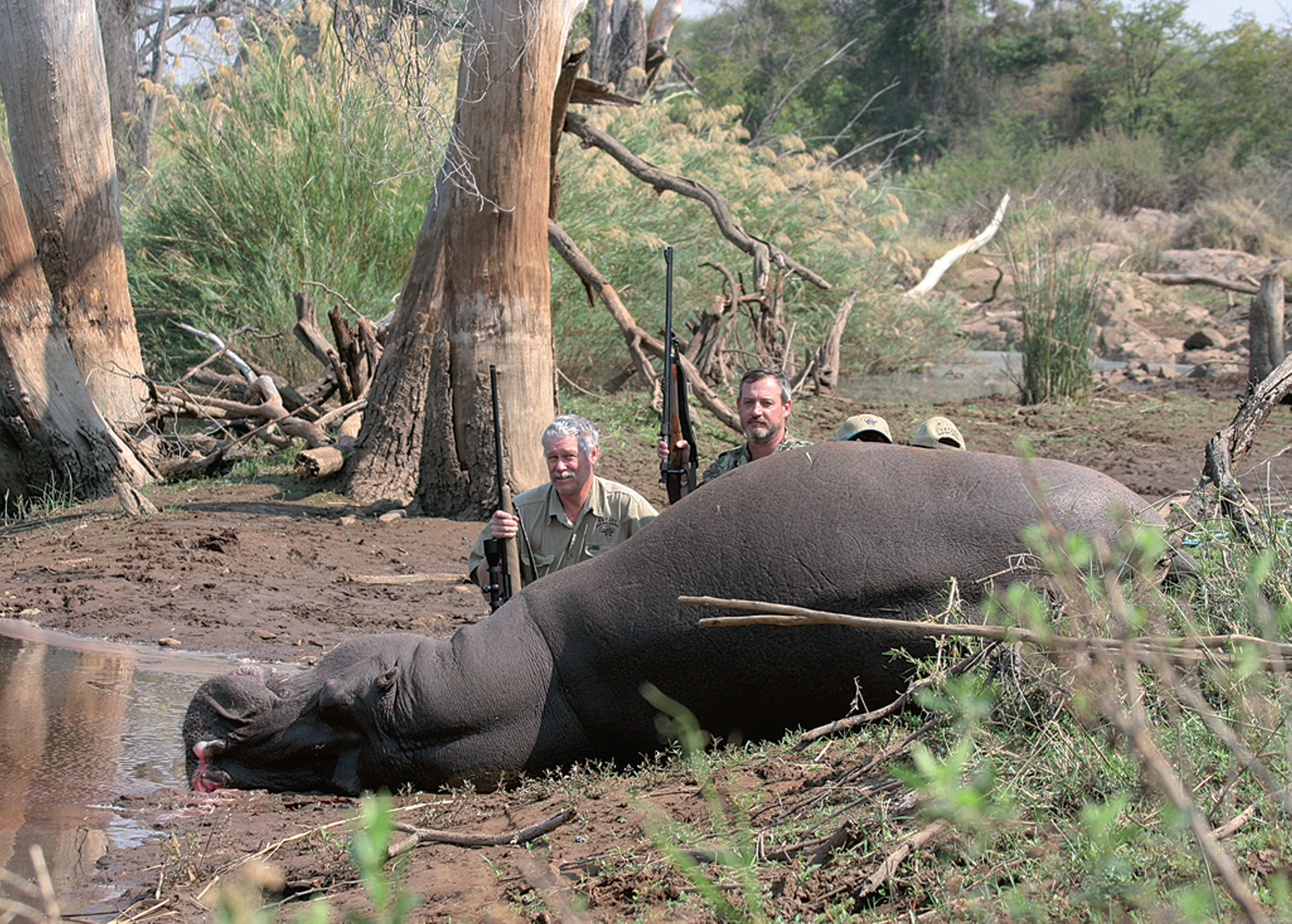
The late Steve Lunceford on the left, and the author holding his .404 built on a double square bridge Mauser action. Steve ended the crop-raiding days of this big hippo bull near the confluence of the Limpopo and Magalakwena rivers. Author was there for the ride. Steve sadly died in an aircraft crash in 2011.
However, the popular sectional density perception is not supported by science. It should not be rejected, but it has more to do with weight retention than pure sectional density.
We have the right idea, we are just tagging it to the wrong definition. We all know that the longer a bullet is, the faster it must spin to remain stable in air. That does not change during the terminal phase, except that an animal’s body is at least 900 times denser than air. It is common knowledge that the denser the medium through which a bullet travels, the faster it must rotate to remain stable and head on.
Given the same mass and twist, a solid .423″ bullet (being shorter and having a lower sectional density than a .416″ bullet) should therefore be more stable than a .416’s during the terminal phase! It is also easier to bend a 6″ rod of a given diameter and material than a 3″ one. So, the longer a bullet is (all else being equal) the more prone it is to bending and losing terminal direction. That however is a separate discussion.
My intention is not to tote the .404 Jeffery as better than the .416’s, but merely to show that a great number of considerations used by hunters to pick one cartridge over the other are not particularly scientific, but merely the result of attempts at rationalization or susceptibility to propaganda. To understand terminal stability and penetration better, readers are advised to study the most authoritative publication ever on penetration, namely the book Bullet Penetration – Modelling the Dynamics and Incapacitation Resulting from Wound Trauma by Duncan MacPherson.
According to CIP specifications the .404 Jeffery is a tad shorter than the .375 H&H Magnum and countless standard length Mauser actions have been successfully converted to handle the .404, by stretching the magazine and doing some work on the rails and ramp. If you load the .404 to standard magnum length this is not a problem, but a good case can be made for rather mating it to stretched actions.
Optics and Sighting
My .404 Jeffery is not scoped and until my eyesight began showing signs of ageing I believed that a dangerous game rifle should not really be scoped. That view is changing as quickly as my ability to see the front sight well.
My favourite iron sight on such a rifle looks like hell, but works extremely well. It consists of a pillar (Patridge) front sight and a large hole ghost ring rear sight on the bridge. Unlike an express sight it does not block the bottom half of the target, which I find increasingly bothersome as my three dimensional perception across the length of a rifle deteriorates. It offers virtual total visual perspective even for ageing eyes. The distance from bridge to front sight is about twice the distance from traditional rear sight to front sight and a lot of parallax is eliminated. It is fast and effective and it does not bother ageing eyes.
I admit to now finding low magnification, wide angle, wide field of view, large exit pupil, long eye relief riflescopes quite effective and with that bit of practice you need when dangerous game hunting, one can actually use a riflescope quite effectively. I have also fallen for electronic reflex sights.
For non dangerous game hunting a 1.5-5x, 2-6x or 2-7x riflescope with long (3.75″+) eye relief all work well on the .404. For dangerous game hunting the best option is a 1.1-4x and second best a 1.25-4x. Since the recoil of the Jeffery is not that bad, riflescopes generally last on these guns.
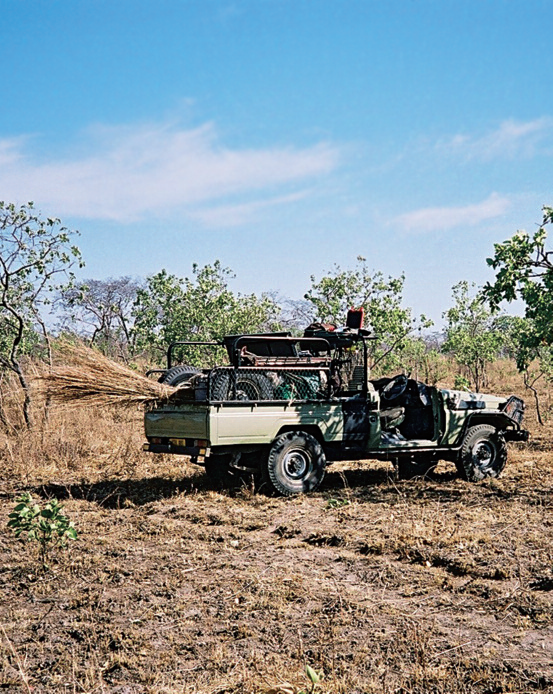
Collecting grass to hang over the lion bait so that the vultures do not get hold of the meat first.
With a riflescope the almost perfect zero is about 90 yards using a 400-gr round nose. It offers a 0.2″ point blank range from about 37-100 yards. Very good for bush hunting. Even at 150 yards it is still within 2.3″ of line of sight, but I have grown so accustomed to my 75-yard zero that I personally do not deviate from it any more.
Handloading
If you load the .404 Jeffery to the CIP specified 3.53″ (89,66mm), a 400-grain Barnes RN solid is seated about 0.74″ (18,8mm) deep into the case, and a Woodleigh 400-grain RN solid about 0.654″ (16,7mm), while calibre is only 0.423″ (10,74mm). Nothing (except magazine length and/or leade) compels anybody to compromise the .404 Jeffery’s combustion space by seating the bullet deeper than a calibre, just to conform to CIP overall cartridge length specs. Particularly because cartridge overall length is changed by handloaders for all sorts of reasons, including accuracy. You don’t have to stick to crimping grooves either, especially if you use a Lee factory crimp die sensibly. Changing overall cartridge length affects pressures and should not be engaged in by the inexperienced.
Actual Case Capacities
| Case Brand | Case Mass | Water Capacity |
| Norma | 298.8 gr | 113.4 gr |
| RWS | 291.5 gr | 114.3 gr |
The .404 Jeffery is a natural to seat the bullet one calibre deep only. It compensates for the sloping shoulder and long neck and increases combustion space. If this approach is followed and the chamber leade is generous, the .404 Jeffery becomes longer than the .375 H&H Magnum and then it requires a magnum length action.
Modern propellants enable handloaders to increase velocities to around 2,350 fps with 400-grain bullets from long leade 24″ barrels without exceeding the original pressure specification by much, or without
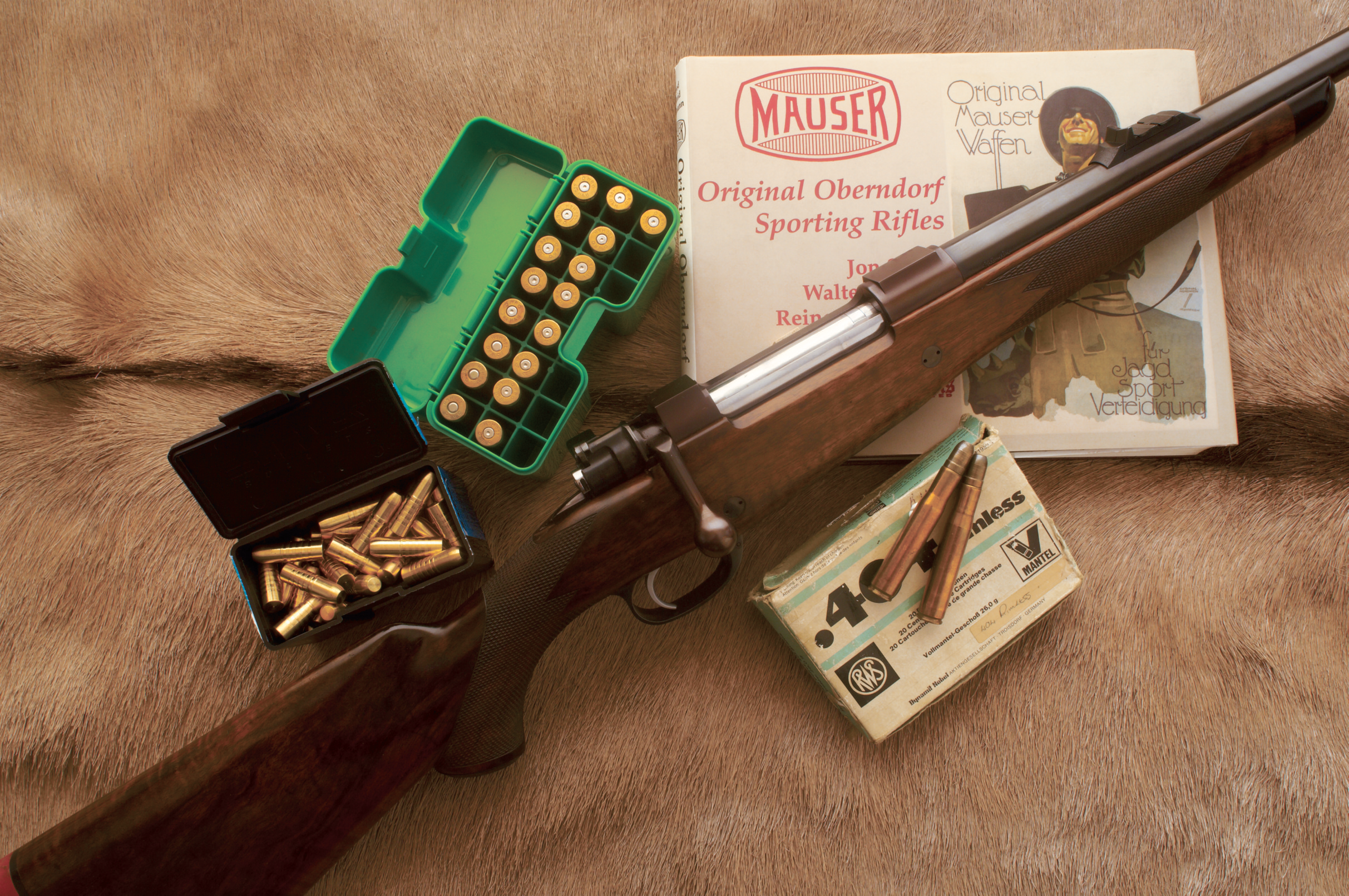
This custom .404 Jeffery on a Vektor Magnum Mauser action is one of the author’s favourite rifles. In patent applications William Jackman Jeffery did not describe himself as a gunmaker. His company did not manufacture rifles or guns. He purchased them from Birmingham gunmakers and sold these under the WJ Jeffery brand name. That is one of the reasons why he did not maintain proprietary rights to the cartridges introduced via his company.
approaching the higher pressure levels which are accepted as the norm for cartridges of late.
If one looks at the various handloading manuals, and also when you punch the dimensional, volumetric and weight data into the better internal ballistic programmes, it becomes obvious that the slower medium burning propellants between Hodgdon’s H-4895 and H-414 provide the best results with the 400-grain bullet. Once the slow burning propellant category is entered into, suitability fast deteriorates. Somchem S-355 and propellants in the IMR-4064 and IMR-4320 class work well in this cartridge.
Although a lot of RWS cases still float around, it ceased making .404 ammunition and components around 2000. At this stage Bertram, Horneber, Kynamco and Reed are the best options for cases. I use Norma cases. They offer great consistency.
Woodleigh makes the most popular .404 bullets, but Barnes, GS Custom, Rhino, Stewart, Swift and RWS also manufacture good stuff. I use Swift, Rhino and Stewart softs. Rhino bullets are not always the dimensionally most consistent and I find that irritating on the handloading side, but when you put bullet to flesh, they work.
When it was active, A-Square also offered .423″ bullets. According to my information A-Square monometal solids were actually conceived and patented by Eric Lutfy of the Thunderbird Cartridge Company in Phoenix, Arizona.
To my mind, the day of the round nose solid has come and gone. The new generation of large meplat solids such as the GS Custom and the North Fork have arrived. I don’t use anything else any more.
The one thing to bear in mind when handloading the .404 case is that it is big. It requires a full size press and proper case lubrication, or the cases get stuck in the dies. It is a candidate for premium quality case lubes such as Imperial Sizing Die Wax.
Due to the .404’s sloping shoulder, great care must be taken not to set the shoulders back. Fortunately it has a long neck and it is easy to only resize it partially.
As with all cartridges intended to be used on dangerous game, full-length resizing of hunting handloads is recommended. Due to the sloping shoulder the cartridge is a smooth feeder and very few problems in this regard are ever encountered on the .404.
Despite the fact that the long necks can fairly easily be buckled when crimps are applied, it is easy to handload.
.404 Jeffery / 10,75 x 73mm Load Data Summary
| Bullet Weight | Propellant Type | Min Load | Max Load | Max Velocity | Barrel Length | Data Source |
| 400-gr | Bullets Accurate AA-2520 | 80.0 gr | 83.0 gr | 2,456 fps | www.loaddata.com. | |
| Alliant Rel-15 | 76.0 gr | 80.0 gr | 2,379 fps | 26.0” | A-Square Any Shot You Want. 1996. | |
| Alliant Rel-12 | 80.0 gr | 83.0 gr | 2,410 fps | 23.6” | N Harvey Reloading Manual. 8th Ed. 2005. | |
| Hodgdon H-4350 | 83.0 gr | 86.0 gr | 2,221 fps | 24.0” | A-Square Any Shot You Want. 1996. | |
| Mulwex AR-2209 | 76.0 gr | 85.0 gr | 2,450 fps | 23.6” | N Harvey Reloading Manual. 8th Ed. 2005. | |
| Mulwex AR-2208 | 68.0 gr | 71.0 gr | 2,100 fps | 26.0” | ADI Handloaders Guide. 5th Ed. 2010. | |
| Mulwex AR-2206 | 75.0 gr | 79.0 gr | 2,358 fps | 23.6” | N Harvey Reloading Manual. 8th Ed. 2005. | |
| Norma MRP-2 | 96.4 gr | 2,343 fps | Norma Data Center. September 2010. | |||
| Norma N-204 | 89.0 gr | 91.0 gr | 2,304 fps | 24.0” | Ladeboken. 6th Ed. 2006. | |
| Norma N-202 | 76.0 gr | 78.0 gr | 2,357 fps | 24.0” | Ladeboken. 6th Ed. 2006. | |
| Norma N-201 | 71.0 gr | 75.0 gr | 2,283 fps | 24.0” | Ladeboken. 6th Ed. 2006. | |
| Rottweil R-907 | 80.0 gr | 84.5 gr | 2,362 fps | 23.6” | RWS Wiederladen Handbuch. 1998. | |
| Rottweil R-903 | 76.0 gr | 81.5 gr | 2,346 fps | 23.6” | RWS Wiederladen Handbuch. 1998. | |
| IMR-4350 | 84.0 gr | 87.0 gr | 2,345 fps | 23.6” | N Harvey Reloading Manual. 8th Ed. 2005. | |
| IMR-4064 | 76.0 gr | 80.0 gr | 2,337 fps | 26.0” | A-Square Any Shot You Want. 1996. | |
| IMR-4895 | 80.0 gr | 83.0 gr | 2,420 fps | 23.6” | N Harvey Reloading Manual. 8th Ed. 2005. | |
| IMR-3031 | 75.0 gr | 79.0 gr | 2,350 fps | 23.6” | N Harvey Reloading Manual. 8th Ed. 2005. | |
| Somchem S-365 | 72.0 gr | 80.0 gr | 2,270 fps | 24.0” | Somchem Data Manual. 1997. | |
| Somchem S-355 | 74.0 gr | 78.0 gr | 2,333 fps | 25.0” | Handload. Not pressure tested. | |
| Vectan Tub-7000 | 78.7 gr | 84.9 gr | 2,313 fps | 26.0” | LHS Germany Data Center. August 2010. | |
| Vectan Tub-Sp11 | 78.7 gr | 81.8 gr | 2,362 fps | 26.0” | LHS Germany Data Center. August 2010. | |
| Vectan Tub-5000 | 79.0 gr | 2,361 fps | 24.0” | Braceras. Manual De Recarga Armas. 2006. | ||
| Vectan Tub-Sp7 | 74.1 gr | 80.2 gr | 2,329 fps | 26.0” | LHS Germany Data Center. August 2010. | |
| Vectan Tub-3000 | 75.0 gr | 2,328 fps | 24.0” | Braceras. Manual De Recarga Armas. 2006. | ||
| Vihtavuori VN-160 | 90.0 gr | 2,161 fps | 24.0” | Ladeboken. 6th Ed. 2006. | ||
| Vihtavuori VN-550 | 82.8 gr | 2,323 fps | 25.6” | Deva Wiederladen. 5th Ed. 2005. | ||
| Vihtavuori VN-150 | 78.0 gr | 80.0 gr | 2,307 fps | 24.0” | Ladeboken. 6th Ed. 2006. | |
| Vihtavuori VN-140 | 74.0 gr | 76.0 gr | 2,295 fps | 24.0” | Ladeboken. 6th Ed. 2006. | |
| Vihtavuori VN-135 | 73.0 gr | 75.0 gr | 2,292 fps | 24.0” | Ladeboken. 6th Ed. 2006. | |
| Winchester WW-748 | 88.0 gr | 2,522 fps | www.loaddata.com. | |||
| 350-gr Bullets | Accurate AA-2520 | 89.0 gr | 2,602 fps | www.loaddata.com. | ||
| Alliant Rel-15 | 86.0 gr | 89.0 gr | 2,630 fps | 23.6” | N Harvey Reloading Manual. 8th Ed. 2005. | |
| Alliant Rel-12 | 85.0 gr | 88.0 gr | 2,570 fps | 23.6” | N Harvey Reloading Manual. 8th Ed. 2006. | |
| Hodgdon H-4895 | 83.0 gr | 87.0 gr | 2,591 fps | www.loaddata.com. | ||
| IMR-4064 | 85.0 gr | 88.0 gr | 2,600 fps | 23.6” | N Harvey Reloading Manual. 8th Ed. 2005. | |
| IMR-4895 | 84.0 gr | 88.0 gr | 2,625 fps | 23.6” | N Harvey Reloading Manual. 8th Ed. 2005. | |
| IMR-3031 | 75.0 gr | 79.0 gr | 2,350 fps | 23.6” | N Harvey Reloading Manual. 8th Ed. 2005. | |
| Mulwex AR-2208 | 84.0 gr | 87.0 gr | 2,610 fps | 23.6” | N Harvey Reloading Manual. 8th Ed. 2005. | |
| Mulwex AR-2206 | 83.0 gr | 86.0 gr | 2,600 fps | 23.6” | N Harvey Reloading Manual. 8th Ed. 2006. | |
| Norma N-204 | 90.0 gr | 2,438 fps | 25.6” | Deva Wiederladen. 5th Ed. 2005. | ||
| Rottweil R-907 | 85.0 gr | 89.0 gr | 2,510 fps | 23.6” | RWS Wiederladen Handbuch. 1998. | |
| Rottweil R-903 | 85.0 gr | 89.0 gr | 2,510 fps | 23.6” | RWS Wiederladen Handbuch. 1998. | |
| Somchem S-341 | 82.0 gr | 86.0 gr | 2,523 fps | 24.0” | Handload. Not pressure tested. | |
| Somchem S-355 | 78.0 gr | 82.5 gr | 2,450 fps | 24.0” | Handload. Not pressure tested. | |
| Vectan Tub-7000 | 82.6 gr | 88.7 gr | 2,493 fps | 26.0” | LHS Germany Data Center. August 2010. | |
| Vectan Tub-Sp11 | 83.3 gr | 89.5 gr | 2,493 fps | 26.0” | LHS Germany Data Center. August 2010. | |
| Vectan Tub-5000 | 81.0 gr | 2,525 fps | 24.0” | Braceras. Manual De Recarga Armas. 2006. | ||
| Vectan Tub-Sp7 | 76.4 gr | 82.6 gr | 2,559 fps | 26.0” | LHS Germany Data Center. August 2010. | |
| Vectan Tub-3000 | 78.0 gr | 2,492 fps | 24.0” | Braceras. Manual De Recarga Armas. 2006. | ||
| Vihtavuori VN-150 | 80.0 gr | 2,411 fps | 25.6” | Deva Wiederladen. 5th Ed. 2005. | ||
| Winchester WW-748 | 87.0 gr | 91.0 gr | 2,568 fps | www.loaddata.com. | ||
| 300-gr Bullets Accurate AA-2520 | 85.0 gr | 89.0 gr | 2,789 fps | www.loaddata.com. | ||
| Alliant Rel-15 | 87.0 gr | 91.0 gr | 2,765 fps | 23.6” | N Harvey Reloading Manual. 8th Ed. 2005. | |
| Hodgdon H-4895 | 85.0 gr | 89.0 gr | 2,729 fps | www.loaddata.com. | ||
| IMR-4895 | 84.0 gr | 87.0 gr | 2,750 fps | 23.6” | N Harvey Reloading Manual. 8th Ed. 2005. | |
| Mulwex AR-2208 | 86.0 gr | 89.0 gr | 2,730 fps | 23.6” | N Harvey Reloading Manual. 8th Ed. 2005. | |
| Vectan Tub-5000 | 86.0 gr | 2,755 fps | 24.0” | Braceras. Manual De Recarga Armas. 2006. |
Bio
Pierre van der Walt grew up on a farm and began hunting from a very young age. He was just ten years old when he took part in his first lion hunt and captured a cub to keep as a pet. During the Angolan War, he served as a combat officer, and subsequently qualified as both a lawyer and a professional hunter. He published his first firearm article in 1992 and has since become Africa’s most prolific outdoor writer. In 2023, he was awarded the John T. Amber Literary Prize by the US publication Gun Digest for an article on the history and evolution of Czech hunting rifles. He has published four books that are internationally recognised as definitive works on hunting cartridges within the African context, and co-authored The Complete Professional Hunter’s Handbook, which is used as the official manual for professional hunter training in South Africa.
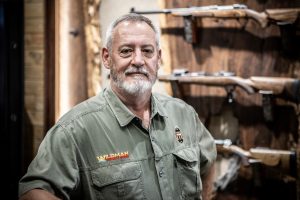
What was said about –
African Small Game Cartridges
African Small Game Cartridges is the third book in the author’s highly acclaimed series on hunting cartridges for Africa. Just like his previous two books (African Dangerous Game Cartridges and African Medium Game Cartridges), African Small Game Cartridges, is the most comprehensive ever discussion of the cartridges covered.
Like the previous books, it is destined to become yet another reference standard, which will serve the international and African hunting, shooting and reloading fraternities for decades. A generous part of African Small Game Cartridges is dedicated to relevant topics such as barrel life, understanding riflescopes, suppressors, and ballistic coefficients.
This coffee table quality reference work extends 480 pages with 350 excellent full colour images and countless performance tables of Africa’s 33 currently most popular .172, .224, 6mm, .257 and 6,5mm hunting cartridges. It takes readers on a grand tour of their history, specifica tions, design features, performance and field application, as well as the reloading quirks of each of these cartridges. African Small Game Cartridges provides unequalled data – around 7,200 loads for American, Australian, African, European and Scandinavian propellants.
International experts have made the following comments about this book
Johan van Wyk (Australia),Editor of SA Hunter magazine
Hunters and shooters are constantly bombarded by marketing onslaughts from all corners, each pretending to be punting the greatest cartridge or item. While progress cannot be halted, we need to sort the wheat from the chaff, especially for the more novice amongst us. With two authoritative books already under his belt, Pierre van der Walt is well qualified to not only steer the inexperienced in the right direction, but to also provide plenty of food for thought for the experienced. I unreservedly give African Small Game Cartridges the thumbs-up. It is well researched and a worthy addition to any shooter’s gunroom.
Mats Bergholm (Sweden) Weapon Systems Expert – Swedish Defence Materiel Administration (FMV)
Pierre van der Walt has done it yet again! His first book, African Dangerous Game Cartridges, is the definitive tome about calibers for Africa’s biggest and deadliest. This book, African Small Game Cartridges, Pierre’s third, is nothing short of a masterpiece. It covers the tiniest ‘African’ calibers, but it is as fascinating from a northern European perspective. The calibers presented also cover calibres used for northern European game hunting, from grouse to elk and non-Africa focused hunters world-wide will benefit equally from this book’s overabundance of information. It fits just as well as a coffee table book in a Swedish moose hunting lodge as it does at a game lodge on the banks of the Limpopo River.
Ira Larivers (Zimbabwe) Editor African Hunter Magazine
Unequalled! The subject matter in this book fills a gap in Africana and international literature. The fact that it was written by the master of the genre, Pierre van der Walt, makes it essential reading. Apart from crucial calibre choices, he also covers many other important topics. Everything is very well presented. It includes a detailed appraisal of the 33 Africa popular small game cartridges, plus some lesser-known gems such as the .224 African. African Small Game Cartridges offers unprecedented cutting-edge information and a myriad of high-quality photos in a lasting format. Don’t miss out.

